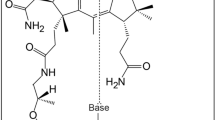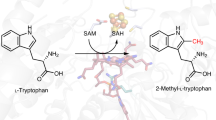Abstract
4-Amino-5-hydroxymethyl-2-methylpyrimidine phosphate (HMP-P) synthase catalyzes a complex rearrangement of 5-aminoimidazole ribonucleotide (AIR) to form HMP-P, the pyrimidine moiety of thiamine phosphate. We determined the three-dimensional structures of HMP-P synthase and its complexes with the product HMP-P and a substrate analog imidazole ribotide. The structure of HMP-P synthase reveals a homodimer in which each protomer comprises three domains: an N-terminal domain with a novel fold, a central (βα)8 barrel and a disordered C-terminal domain that contains a conserved CX2CX4C motif, which is suggestive of a [4Fe-4S] cluster. Biochemical studies have confirmed that HMP-P synthase is iron sulfur cluster–dependent, that it is a new member of the radical SAM superfamily and that HMP-P and 5′-deoxyadenosine are products of the reaction. Mössbauer and EPR spectroscopy confirm the presence of one [4Fe-4S] cluster. Structural comparisons reveal that HMP-P synthase is homologous to a group of adenosylcobalamin radical enzymes. This similarity supports an evolutionary relationship between these two superfamilies.
This is a preview of subscription content, access via your institution
Access options
Subscribe to this journal
Receive 12 print issues and online access
$259.00 per year
only $21.58 per issue
Buy this article
- Purchase on Springer Link
- Instant access to full article PDF
Prices may be subject to local taxes which are calculated during checkout





Similar content being viewed by others
References
Begley, T.P. et al. Thiamin biosynthesis in prokaryotes. Arch. Microbiol. 171, 293–300 (1999).
Settembre, E., Begley, T.P. & Ealick, S.E. Structural biology of enzymes of the thiamin biosynthesis pathway. Curr. Opin. Struct. Biol. 13, 739–747 (2003).
Chatterjee, A., Jurgenson, C.T., Schroeder, F.C., Ealick, S.E. & Begley, T.P. Thiamin biosynthesis in eukaryotes: characterization of the enzyme-bound product of thiazole synthase from Saccharomyces cerevisiae and its implications in thiazole biosynthesis. J. Am. Chem. Soc. 128, 7158–7159 (2006).
Chatterjee, A., Jurgenson, C.T., Schroeder, F.C., Ealick, S.E. & Begley, T.P. Biosynthesis of thiamin thiazole in eukaryotes: conversion of NAD to an advanced intermediate. J. Am. Chem. Soc. 129, 2914–2922 (2007).
Jurgenson, C.T., Chatterjee, A., Begley, T.P. & Ealick, S.E. Structural insights into the function of the thiamin biosynthetic enzyme Thi4 from Saccharomyces cerevisiae. Biochemistry 45, 11061–11070 (2006).
Kriek, M. et al. Thiazole synthase from Escherichia coli: an investigation of the substates and purified proteins required for activity in vitro. J. Biol. Chem. 282, 17413–17423 (2007).
Lawhorn, B.G., Mehl, R.A. & Begley, T.P. Biosynthesis of the thiamin pyrimidine: the reconstitution of a remarkable rearrangement reaction. Org. Biomol. Chem. 2, 2538–2546 (2004).
Newell, P.C. & Tucker, R.G. Biosynthesis of the pyrimidine moiety of thiamine. A new route of pyrimidine biosynthesis involving purine intermediates. Biochem. J. 106, 279–287 (1968).
Zeidler, J., Sayer, B.G. & Spenser, I.D. Biosynthesis of vitamin B1 in yeast. Derivation of the pyrimidine unit from pyridoxine and histidine. Intermediacy of urocanic acid. J. Am. Chem. Soc. 125, 13094–13105 (2003).
Frey, P.A. & Booker, S.J. Radical mechanisms of S-adenosylmethionine-dependent enzymes. Adv. Protein Chem. 58, 1–45 (2001).
Wang, S.C. & Frey, P.A. S-adenosylmethionine as an oxidant: the radical SAM superfamily. Trends Biochem. Sci. 32, 101–110 (2007).
Sofia, H.J., Chen, G., Hetzler, B.G., Reyes-Spindola, J.F. & Miller, N.E. Radical SAM, a novel protein superfamily linking unresolved steps in familiar biosynthetic pathways with radical mechanisms: functional characterization using new analysis and information visualization methods. Nucleic Acids Res. 29, 1097–1106 (2001).
Dougherty, M.J. & Downs, D.M. A connection between iron-sulfur cluster metabolism and the biosynthesis of 4-amino-5-hydroxymethyl-2-methylpyrimidine pyrophosphate in Salmonella enterica. Microbiology 152, 2345–2353 (2006).
Raschke, M. et al. Vitamin B1 biosynthesis in plants requires the essential iron sulfur cluster protein, THIC. Proc. Natl. Acad. Sci. USA 104, 19637–19642 (2007).
Reddick, J.J., Nicewonger, R. & Begley, T.P. Mechanistic studies on thiamin phosphate synthase: evidence for a dissociative mechanism. Biochemistry 40, 10095–10102 (2001).
Park, J.-H., Burns, K., Kinsland, C. & Begley, T.P. Characterization of two kinases involved in thiamine pyrophosphate and pyridoxal phosphate biosynthesis in Bacillus subtilis: 4-amino-5-hydroxymethyl-2-methylpyrimidine kinase and pyridoxal kinase. J. Bacteriol. 186, 1571–1573 (2004).
Cicchillo, R.M. et al. Escherichia coli lipoyl synthase binds two distinct [4Fe-4S] clusters per polypeptide. Biochemistry 43, 11770–11781 (2004).
Münck, E. in Physical Methods in Bioinorganic Chemistry (ed. Que, L. Jr.) 287–319 (University Science Books, Sausalito, California, USA, 2000).
Vallazza, M. et al. First look at RNA in L-configuration. Acta Crystallogr. D Biol. Crystallogr. 60, 1–7 (2004).
Layer, G., Moser, J., Heinz, D.W., Jahn, D. & Schubert, W.D. Crystal structure of coproporphyrinogen III oxidase reveals cofactor geometry of radical SAM enzymes. EMBO J. 22, 6214–6224 (2003).
Hanzelmann, P. & Schindelin, H. Crystal structure of the S-adenosylmethionine-dependent enzyme MoaA and its implications for molybdenum cofactor deficiency in humans. Proc. Natl. Acad. Sci. USA 101, 12870–12875 (2004).
Lepore, B.W., Ruzicka, F.J., Frey, P.A. & Ringe, D. The x-ray crystal structure of lysine-2,3-aminomutase from Clostridium subterminale. Proc. Natl. Acad. Sci. USA 102, 13819–13824 (2005).
Reitzer, R. et al. Glutamate mutase from Clostridium cochlearium: the structure of a coenzyme B12-dependent enzyme provides new mechanistic insights. Structure 7, 891–902 (1999).
Berkovitch, F. et al. A locking mechanism preventing radical damage in the absence of substrate, as revealed by the x-ray structure of lysine 5,6-aminomutase. Proc. Natl. Acad. Sci. USA 101, 15870–15875 (2004).
Evans, J.C. et al. Structures of the N-terminal modules imply large domain motions during catalysis by methionine synthase. Proc. Natl. Acad. Sci. USA 101, 3729–3736 (2004).
Mancia, F. et al. How coenzyme B12 radicals are generated: the crystal structure of methylmalonyl-coenzyme A mutase at 2 Å resolution. Structure 4, 339–350 (1996).
Svetlitchnaia, T., Svetlitchnyi, V., Meyer, O. & Dobbek, H. Structural insights into methyltransfer reactions of a corrinoid iron-sulfur protein involved in acetyl-CoA synthesis. Proc. Natl. Acad. Sci. USA 103, 14331–14336 (2006).
Frey, P.A. Radical mechanisms of enzymatic catalysis. Annu. Rev. Biochem. 70, 121–148 (2001).
Berkovitch, F., Nicolet, Y., Wan, J.T., Jarrett, J.T. & Drennan, C.L. Crystal structure of biotin synthase, an S-adenosylmethionine-dependent radical enzyme. Science 303, 76–79 (2004).
Matthews, B.W. Solvent content of protein crystals. J. Mol. Biol. 33, 491–497 (1968).
Otwinowski, Z. & Minor, W. Processing of X-ray diffraction data collected in oscillation mode. Methods Enzymol. 276, 307–326 (1997).
Schneider, T.R. & Sheldrick, G.M. Substructure solution with SHELXD. Acta Crystallogr. D Biol. Crystallogr. 58, 1772–1779 (2002).
Uson, I. & Sheldrick, G.M. Advances in direct methods for protein crystallography. Curr. Opin. Struct. Biol. 9, 643–648 (1999).
Otwinowski, Z. in CCP4 Proceedings (eds. Wolf, W., Evans, P.R. & Leslie, A.G.W.) 80–88 (SERC Daresbury Laboratory, Warrington, UK, 1991).
Terwilliger, T.C. Maximum-likelihood density modification. Acta Crystallogr. D Biol. Crystallogr. 56, 965–972 (2000).
Jones, T.A., Zou, J.-Y., Cowan, S.W. & Kjeldgaard, M. Improved methods for the building of protein models in electron density maps and the location of errors in these models. Acta Crystallogr. A 47, 110–119 (1991).
Emsley, P. & Cowtan, K. Coot: model-building tools for molecular graphics. Acta Crystallogr. D Biol. Crystallogr. 60, 2126–2132 (2004).
Brünger, A.T. et al. Crystallography & NMR system: a new software suite for macromolecular structure determination. Acta Crystallogr. D Biol. Crystallogr. 54, 905–921 (1998).
Laskowski, R.A., Moss, D.S. & Thornton, J.M. Main-chain bond lengths and bond angles in protein structures. J. Mol. Biol. 231, 1049–1067 (1993).
Krissinel, E. & Henrick, K. Secondary-structure matching (SSM), a new tool for fast protein structure alignment in three dimensions. Acta Crystallogr. D Biol. Crystallogr. 60, 2256–2268 (2004).
Kabsch, W., Kabsch, H. & Eisenberg, D. Packing in a new crystalline form of glutamine synthetase from Escherichia coli. J. Mol. Biol. 100, 283–291 (1976).
Gouet, P., Courcelle, E., Stuart, D.I. & Metoz, F. ESPript: analysis of multiple sequence alignments in PostScript. Bioinformatics 15, 305–308 (1999).
Jones, S. & Thornton, J.M. Protein-protein interactions: a review of protein dimer structures. Prog. Biophys. Mol. Biol. 63, 31–65 (1995).
Jones, S. & Thornton, J.M. Principles of protein-protein interactions. Proc. Natl. Acad. Sci. USA 93, 13–20 (1996).
DeLano, W.L. The PyMOL Molecular Graphics System (DeLano Scientific, San Carlos, California, USA, 2002).
Potterton, E., McNicholas, S., Krissinel, E., Cowtan, K. & Noble, M. The CCP4 molecular-graphics project. Acta Crystallogr. D Biol. Crystallogr. 58, 1955–1957 (2002).
Martinez-Gomez, N.C. & Downs, D.M. ThiC is an [Fe-S] cluster protein that requires AdoMet to generate the 4-amino-5-hydroxymethyl-2-methylpyrimidine moiety in thiamin synthesis. Biochemistry 47, 9054–9056 (2008).
Acknowledgements
We thank NE-CAT beamline 24-ID-C, supported by US National Institutes of Health grant RR15301, for the use of beam time. We thank C. Kinsland (Cornell University Protein Facility) for the preparation of the HMP-P synthase overexpression plasmid and L. Kinsland for assistance in the preparation of this manuscript. This work was supported by US National Institutes of Health grants DK44083 (T.P.B.), GM63847 (S.J.B.) and DK67081 (S.E.E.), the Beckman Foundation (Young Investigator Award to C.K.) and the Dreyfus Foundation (Camille Dreyfus Teacher Scholar Award to C.K.). S.E.E. is indebted to the W.M. Keck Foundation and the Lucille P. Markey Charitable Trust.
Author information
Authors and Affiliations
Contributions
A.C. performed all biochemical studies. Y.L. and Y.Z. performed all crystallographic studies. T.L.G. assisted in protein purification and EPR spectroscopy. M.L. recorded and analyzed Mössbauer spectra. C.K. and S.J.B. directed the EPR and Mössbauer studies, T.P.B. directed the biochemical studies and S.E.E. directed the crystallographic studies.
Corresponding authors
Supplementary information
Supplementary Text and Figures
Supplementary Figures 1–7, Supplementary Tables 1 and 2, and Supplementary Methods (PDF 6947 kb)
Rights and permissions
About this article
Cite this article
Chatterjee, A., Li, Y., Zhang, Y. et al. Reconstitution of ThiC in thiamine pyrimidine biosynthesis expands the radical SAM superfamily. Nat Chem Biol 4, 758–765 (2008). https://doi.org/10.1038/nchembio.121
Received:
Accepted:
Published:
Issue Date:
DOI: https://doi.org/10.1038/nchembio.121
This article is cited by
-
Non-canonical active site architecture of the radical SAM thiamin pyrimidine synthase
Nature Communications (2015)
-
Radical SAM enzyme QueE defines a new minimal core fold and metal-dependent mechanism
Nature Chemical Biology (2014)
-
The radical SAM enzyme AlbA catalyzes thioether bond formation in subtilosin A
Nature Chemical Biology (2012)
-
Radical-mediated enzymatic carbon chain fragmentation-recombination
Nature Chemical Biology (2011)
-
Radical break-up, blissful make-up
Nature Chemical Biology (2011)



